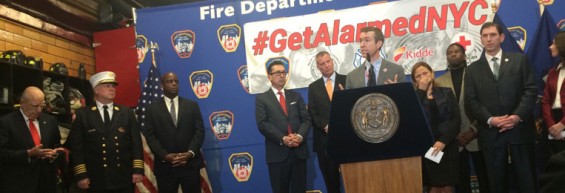
Dec. 3, 2015 By Michael Florio
The Red Cross will distribute free smoke and carbon monoxide alarms throughout Jackson Heights this Saturday.
The Red Cross will have hundreds of staff members and volunteers going to Jackson Heights to install 10-year smoke and carbon monoxide alarms in homes that do not have working devices. Residents will also learn about fire safety from trained volunteers.
Residents all over Jackson Heights are welcome to sign up to receive a smoke and carbon monoxide alarm, according to Abigail Adams with the Red Cross. So far, more than 60 residents have scheduled appointments for this Saturday.
Those interested in scheduling an appointment can call 1-877-REDCROSS or visit www.redcross.org/GetAlarmedNYC.
Teams will be installing the alarms around the neighborhood. For security reasons, all of the install team members will be wearing red vests and have Red Cross IDs.
This is part of the Red Cross’ #GetAlarmedNYC fire safety initiative.
The $4 million initiative will provide free installation and distribution of 100,000 photoelectric combination smoke/carbon monoxide alarms to tens of thousands of city residents over the next two years.
The effort was spurred by the deaths of seven children last March in a fire in Midwood, Brooklyn.
According to the Red Cross, the National Fire Protection Association estimates that nationally, the risk of dying in a home fire is cut in half when there’s a working smoke alarm present. In New York City, the FDNY Bureau of Fire Investigations has determined that up to 70 percent of fire deaths in recent years have occurred in residences where there was no working smoke alarm – either with no alarm present, or missing or dead batteries in a device.
On average, 7 people die from a home fire every day in the U.S. and 36 people suffer injuries from home fires every day in the U.S., according to the Red Cross.
The Red Cross is targeting communities in all five boroughs that pose the greatest risks from fire, according to FDNY statistics and analysis.
They look to do so in several Queens neighborhoods, including north Corona, Flushing and East Elmhurst.





